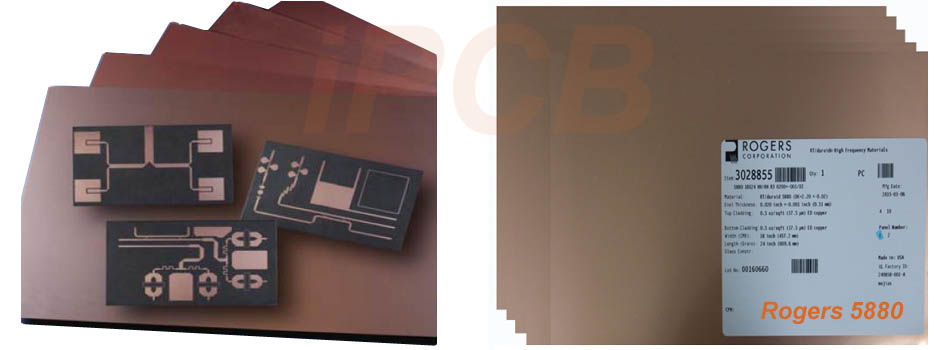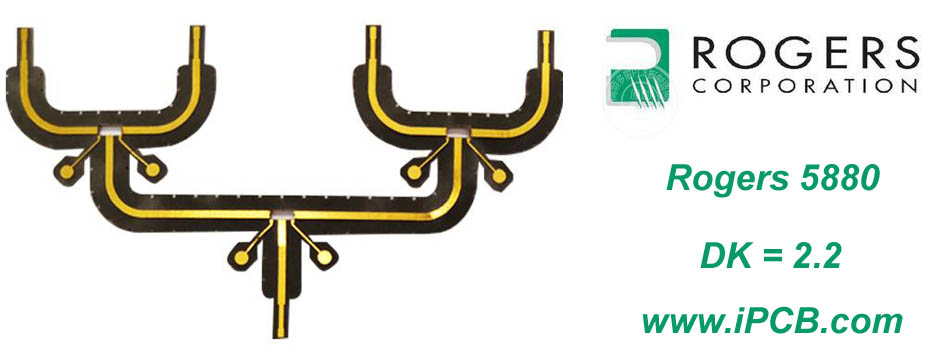Model: Rogers 5880 PCB
Material: rogers 5880 substrate
Layer: 1Layer - 24 layer
RT duroid 5880 dielectric constant: 2.2
5880 thickness: 0.2mm - 4.8mm
Surface Treatment : Immersion Gold
Rogers 5880 thickness: Base 0.5OZ,Finished 1OZ
Special process: Teflon multilayer pcb, Countersink PCB
Application: microwave, instrument, communication
Rogers 5880 PCB is high frequency PCB, which is mainly used for point-to-point digital radio antenna, microstrip line and stripline circuit, millimeter wave application, missile guidance system, military radar system and high-frequency circuit board of commercial aviation telephone.
Rogers 5880 copper clad laminates are usually fabricated by directly bonding Teflon components of the laminate to the surface of the foil. If electrodeposition is used, the spherical joint surface of ED foil will be mechanically interlocked with Teflon.
Rogers RT Duroid 5880 thickness is the dielectric thickness of the material without copper, which makes it easier to calculate the impedance of high frequency PCB. The thickness of rt5880 material is: 0.127mm, 0.254mm, 0.381mm, 0.508mm, 0.787mm, 1.575mm and 3.175mm
The base copper thickness of rt5880 material is 0.5oz (18um), 1oz (35um), 2oz (70UM). Ipcb is usually made of 0.5oz (18um) base copper and Rogers 5880 substrate 18um. The finished copper thickness of Rogers 5880 PCB is about 1oz
Features of Rogers 5880
1. Extremely low electrical loss opportunities for any PTFE-reinforced materials
2. Low hygroscopicity
3. Rogers 5880 substrate isotropy
4. Uniform electrical performance at high frequencies
5. Excellent chemical resistance, including solvents and reagents for printing and coating
6. Friendly environment for use
Rogers 5880 high frequency laminate series uses PTFE composite materials to enhance glass fibers. These microfibers are statistically oriented to maximize the benefits of optical gain, providing the most valuable direction for circuit manufacturers and end-use applications. These high frequency laminates have the lowest dielectric constant in all products and low dielectric loss makes them suitable for high frequency/broadband applications where dispersion and loss must be minimized. Because of its very low water absorption, RT Duroid 5880 is ideal for use in high humidity environments.
These advanced high frequency PCB materials can be easily cut, cut and processed to form any solvent and reagent commonly used in PCB boards or to electroplate edges and holes. They have very low electrical loss for any enhanced PTFE material, and they also have very low moisture absorption and are isotropic. They have uniform electrical properties in frequency. Rogers 5880 is designed for the rigorous application of integrated circuits and microcircuits.
Roger PCB material has the lowest DK value of high frequency PCB material available on the market. Due to its low dielectric constant of 1.96 at 10 GHz, RT Duroid 5880 supports broadband applications at millimeter microwave frequencies with minimal dispersion and circuit loss. It is a single-filled, lightweight PTFE (Teflon) composite with extremely low density (1.37 g/cm3) and low thermal expansion factor (CTE) on the Z-axis, which provides high frequency fabrication (PTH) holes and enables higher payloads. In addition, the dielectric constant from the plate to the panel is uniform and constant over a wide frequency range, and the Z-axis TCDk is as low as +22ppm/C.

Rogers 5880 substrate
Due to the thermal stability of Rogers Duroid 5880 PCB, people seldom pay attention to the precise control of welding process, but sometimes they encounter joint problems in the process of solver. Especially in the assembly and rework process when using rough control of manual soldering tools.
We designed an experiment to detect the effect of temperature on the bonding strength between copper foil and RT / Duroid 5880 . The test sample is a 0.062 inch (1.59 mm thick) RT / Duroid 5880 laminate covered with 1 oz ft2 (34 mm thick) ed copper foil. In the experiment, the samples were exposed to a series of different temperatures (from 182 degree Celsius to 371 degree Celsius). The sample consists of 1 / 8 inch (3 mm) wide copper wire with a 1 / 4 inch liner at one end. The copper wire and pad are etched on a 2 inch square laminate specimen.
The experimental measurement consists of three parts
1. Cold peel strength: after the RT / Duroid 5880 sample floated on the solder for 30 seconds, the force required to peel the 1 / 8 inch (3.2mm) wide copper wire from the substrate at an angle of 90 ° was measured under the ambient temperature of 21 degree Celsius.
2. Thermal peel strength: after the RT / Duroid 5880 sample is immersed in solder and stabilized for one minute, measure the force required to peel 1 / 8 inch wide copper wire from the substrate at a 90 ° angle
3. Thermal shear strength: peel the 1 / 8 inch wide copper wire from the substrate, leaving only the liner at the end, immerse the RT / duroid5880 sample in the solder and stabilize it for one minute, pull the 1 / 8 inch wide copper wire, and measure the tensile force required to make the liner separate from the substrate.
The cold peel strength shows that when the temperature is close to the melting point of Teflon PCB(327 degree Celsius), the joint between teflon and Cu foil begins to be destroyed. At this temperature, Cu in contact with air is easy to oxidize. At the same time, when the phase transition of teflon begins, the protective effect of air isolation provided by PTFE bonding with the surface of metal foil will gradually lose.
The thermal peel strength and shear stress show that the joint of Teflon and Cu foil is easy to be damaged at high temperature. Therefore, attention should be paid to manual soldering to avoid excessive temperature or stress.

Rogers 5880 PCB
RT / Duroid 5880 PCB material is manufactured with the same high-quality, reliable materials and processes as Rogers, enabling Rogers to win important awards from high-frequency material manufacturers. In some designs, the dielectric properties of the PCB are critical. Whether it is a high-speed PCB, RF PCB, or microwave PCB, you will find that PCB prototypes require more PCB dielectric properties than standard FR-4 cannot provide. we know. This is why we use Rogers 5880 dielectric material. These new low-loss dielectric materials mean higher performance for demanding PCB prototypes.
Rogers 5880 PCB is high frequency PCB, iPCB provides technical support for Rogers duroid 5888 and cheap Rogers rt duroid 5880 price.
Model: Rogers 5880 PCB
Material: rogers 5880 substrate
Layer: 1Layer - 24 layer
RT duroid 5880 dielectric constant: 2.2
5880 thickness: 0.2mm - 4.8mm
Surface Treatment : Immersion Gold
Rogers 5880 thickness: Base 0.5OZ,Finished 1OZ
Special process: Teflon multilayer pcb, Countersink PCB
Application: microwave, instrument, communication
For PCB technical problems, iPCB knowledgeable support team is here to help you with every step. You can also request PCB quotation here. Please contact E-mail sales@ipcb.com
We will respond very quickly.